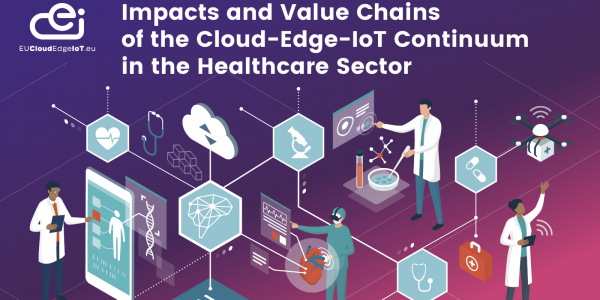The healthcare industry faced disruption and tremendous challenges due to the COVID-19 pandemic, which revealed many ways technology, in general, and CEI, in particular, can help the industry to become more resilient, reduce the risk of infection, increase productivity, monitor patients more effectively, and achieve better health results with limited resources.
The following “Industry Spotlight Use Cases” sections are curated based on comprehensive surveys conducted by IDC in 2023, targeting market and industry professionals across Europe. The examples accompanying each spotlight use case category are derived from use cases executed by the Research and Innovation Action teams within the EUCloudEdgeIoT community. As research progresses, we will continue to update this information to reflect the latest findings and developments.
Spotlight use case categories

Hospital asset tracking
Hospitals feature a constant flow of patients, staff, beds, monitoring equipment, medications and other valuable assets throughout the facilities. In this environment, it is important to know where assets are, and which ones are available, and to quickly get them to places where they are needed. With wireless connectivity, hospitals can track assets, reduce losses, increase utilisation, and ensure faster access to needed treatments. As such these use cases can enable improved quality of patient care, increased safety, reduced losses and theft, optimised usage, reduced inventory, and ultimately, better care and tighter control of costs. Furthermore, once the data is collected, this use case can be integrated with ERP, security, inventory management and work management systems, allowing for wider hospital digitalisation. it is one of the most widely used (58% of healthcare respondents use it now) and it enables a wide range of additional technology solutions in the healthcare space. As hospitals have large facilities and IT technology concentrated in a building or campus, they have the resources and staffing to support local IT systems. They also face strict pressures on data privacy, which sometimes leads to decisions to handle data locally and internally. Therefore, hospital asset tracking is likely to use a significant amount of edge computing.
Sub-category use-cases
- Asset tracking and monitoring
- Patient tracking and monitoring
- Bed tracking and monitoring
- Resource scheduling
- Medicine and controlled substances security and tracking
- Inventory management
Projects use-cases

Bedside telemetry
Some patients' physiological status requires close attention. In this use case, the patients can be constantly monitored using IoT-driven, bedside monitoring. Such a system can raise automated alerts to ensure faster response from healthcare providers and summarise and analyse data to provide a dashboard of crucial information to the staff monitoring patients. By doing so, the system should enable better care and outcomes while making more efficient use of limited staff. it provides direct benefits to a core function of the healthcare industry. It is widely used (53% of healthcare respondents, currently). Yet it differs from the asset tracking use case, as the data it collects, transmits and analyses is far more critical. Patient data is handled differently than asset tracking data, and abuses could be more life-threatening. As such, this use case requires different considerations in terms of reliability, security, data management, privacy, analytics and usage. Given the critical issues of urgent patient care and privacy, this type of solution is likely to employ sensors to collect comprehensive physiological information, use edge infrastructure to collect and analyse the data and raise alerts, summarizes data for different healthcare provider needs and for local management; and uses cloud computing to train analytics models and provide consolidated management.
Sub-category use-cases
- Patient EKG monitoring
- Cameras and imagery analysis
- Prevent falls
- Respond to emergency conditions
- Drug pumps
Projects use-cases
Remote Healthcare
Concept:
The current ultrasound medical imaging processes are constrained by both the technical features of the local device and the knowledge of the local healthcare operator.
Connect, decompose and virtualize ultrasound medical imaging systems into the cloud-edge continuum to lose any barriers due to the hardware capabilities and localization of current physical systems.
Benefits:
Allows to exchange data and resources among the physical components involved in the use case.
Provide additional capabilities such as distributed data management and analysis.
Allow the orchestration of data and resources between the cloud and edge computing orchestration platforms.
Virtualize ultrasound medical imaging systems into the cloud-edge continuum.

AI-assisted diagnosis and treatment
Patient data and health scans require expert analysis for diagnosis, but problems may be difficult to detect at an early stage. AI systems can assist experts and point to areas of concern at an early stage. They extract insights from the intersection of diverse data sets, including medical records, lab tests, clinical studies, medical images, and other sources, to assist in diagnosis and recommend personalised treatment at the individual patient level. As such, this use case has the potential to help healthcare providers detect problems earlier and treat them more effectively, leading to better health outcomes and lower costs. The use case is in the early stages of development, and it relies on artificial intelligence, which is a critical and rapidly developing technology that could shape much of the CEI space in the future. This use case also differs greatly from the others selected and will require quite different solutions, architectures and value chains. AI-assisted diagnosis and treatment systems generate large data volumes locally, particularly with high-resolution imaging. Some of this data will be shared back to cloud-based systems for analysis and training of AI models. However, much of the analysis of individual images is likely to be done locally. The updated models will be placed on edge computing and used to analyse new images and data.
Sub-category use-cases
- AI analysis of medical images and scans
- AI recommendation engine for treatments
- Data/imagery management systems for training AI models, deploying them to the edge and updating them as AI models improve


